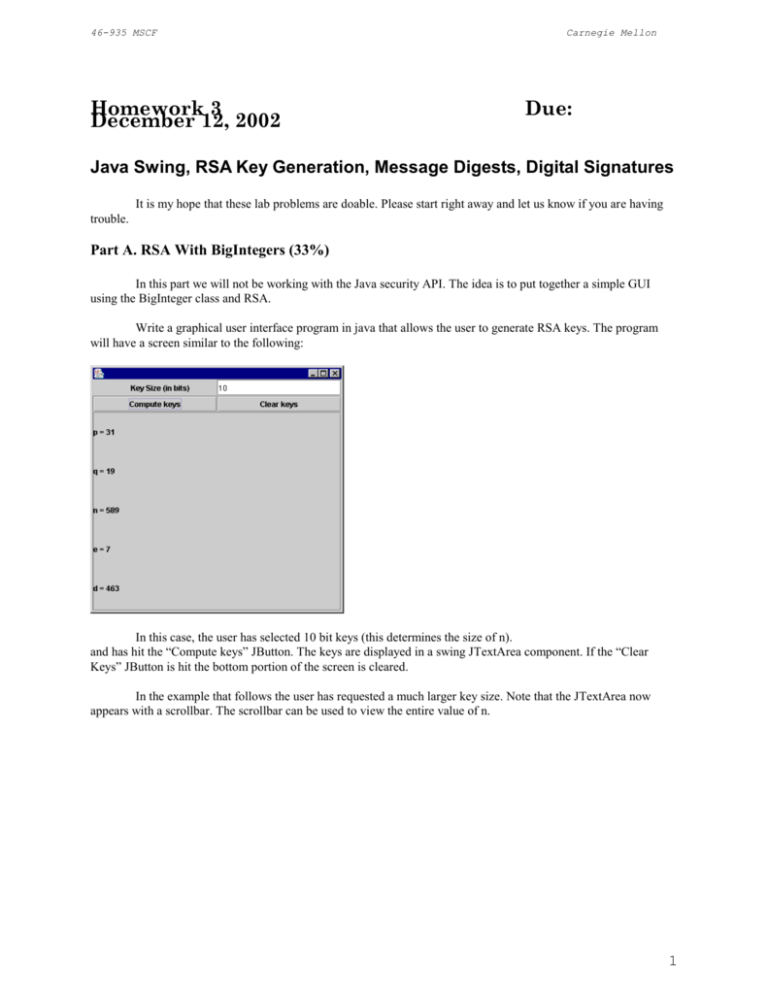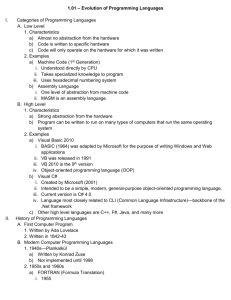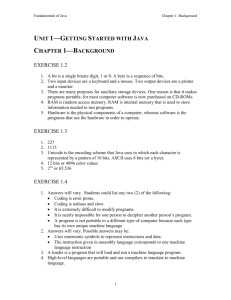
46-935 MSCF
Homework 3
December 12, 2002
Carnegie Mellon
Due:
Java Swing, RSA Key Generation, Message Digests, Digital Signatures
It is my hope that these lab problems are doable. Please start right away and let us know if you are having
trouble.
Part A. RSA With BigIntegers (33%)
In this part we will not be working with the Java security API. The idea is to put together a simple GUI
using the BigInteger class and RSA.
Write a graphical user interface program in java that allows the user to generate RSA keys. The program
will have a screen similar to the following:
In this case, the user has selected 10 bit keys (this determines the size of n).
and has hit the “Compute keys” JButton. The keys are displayed in a swing JTextArea component. If the “Clear
Keys” JButton is hit the bottom portion of the screen is cleared.
In the example that follows the user has requested a much larger key size. Note that the JTextArea now
appears with a scrollbar. The scrollbar can be used to view the entire value of n.
1
46-935 MSCF
Carnegie Mellon
The program will be called KeyGenApp.java and must make use of Java’s BigInteger class.
The program will be placed on blackboard. The grader must be able to run the program by downloading
your code and by typing java KeyGenApp.
The program will be graded according the following criteria:
Does the program compile and run as described (two working buttons) ? _____ 50
Does the window contain a scrollbar when n is very large? ______ 10
Is the program code documented well. ? _____ 10
Is the program code indented and is spacing used so that it is easy to read? _____ 5
Are variable names chosen well? _____ 5
Does the program contain a block of initial documentation like author, date, class, etc.? ______ 10
Does the application allow for repetitive use. That is, can the user to enter one key size, view the keys, and
then change to another key size without having to restart the program? _______ 10
2
46-935 MSCF
Carnegie Mellon
Part B. Message digests (33%)
In this part we will be working with the Java API associated with message digests. Use the program shown
below as a starting point.
Message digests are likely to play an increasingly important roll in computer communications. They can be
used with public key encryption to create digital signatures. They also play an important roll in document
verification. If the document changes even slightly, the message digest will change as well.
A message digest algorithm takes as input an arbitrary series of bytes and computes an integer as a function
of those bytes. If the algorithm is good then it is computationally hard to find another series of bytes that generates
the same integer. In other words, the resulting value is like a fingerprint of the series of bytes. In Java we can use the
SHA1 and MD5 algorithms to compute message digests. The following problems are designed to acquaint you with
message digests and give you more experience working with Swing.
Please answer the following questions and, where appropriate, submit your answers directly on this
document. Place the document on blackboard. Question 3 also asks you to paste a copy of your Java solution on
blackboard.
The program below, MessageDigestApplet.java, computes a message digest from a file or from text entered by
the user. Run this program using the appletviewer program. The appletviewer program takes an HTML file as input
and loads and runs the class file contained within it.
(1) What is the message digest of the following string. Note that this string has exactly 12 characters. There is
no carriage return at the end. The last character is a period. Show your answers in hexadecimal bytes.
Hello World.
a) MD5 Message Digest _____________________________ 10 Points
b) SHA1 Message Digest _____________________________ 10 Points
(2) What is the message digest of the program MessageDigestApplet.java?
a) MD5 Message Digest _____________________________ 10 Points
b) SHA1 Message Digest _____________________________ 10 Points
(3) Modify the program so that it is a Java application rather than an applet. Also, allow the user to
select a file at a particular URL. You will need to add a button that says “URL Digest”. When that button is
clicked a JOptionPane will be displayed that asks the user for the URL. The file will then be
fetched from the internet and the digest computed and displayed. Paste a screen shot of your program running
here. Call this program MessageDigestApplication.java and place a copy on blackboard.
(4) Use the Java application program that you developed to compute the SHA1 message digest of the
FpML file example_1.xml found under
http://dewdney.heinz.cmu.edu:8080/financial/example_1.xml.
SHA1 Message Digest of example_1.xml ____________________ 10 Points
3
46-935 MSCF
Carnegie Mellon
/*
* Cay S. Horstmann & Gary Cornell, Core Java
* Published By Sun Microsystems Press/Prentice-Hall
* Copyright (C) 1997 Sun Microsystems Inc.
* All Rights Reserved.
*
* Permission to use, copy, modify, and distribute this
* software and its documentation for NON-COMMERCIAL purposes
* and without fee is hereby granted provided that this
* copyright notice appears in all copies.
*
* THE AUTHORS AND PUBLISHER MAKE NO REPRESENTATIONS OR
* WARRANTIES ABOUT THE SUITABILITY OF THE SOFTWARE, EITHER
* EXPRESS OR IMPLIED, INCLUDING BUT NOT LIMITED TO THE
* IMPLIED WARRANTIES OF MERCHANTABILITY, FITNESS FOR A
* PARTICULAR PURPOSE, OR NON-INFRINGEMENT. THE AUTHORS
* AND PUBLISHER SHALL NOT BE LIABLE FOR ANY DAMAGES SUFFERED
* BY LICENSEE AS A RESULT OF USING, MODIFYING OR DISTRIBUTING
* THIS SOFTWARE OR ITS DERIVATIVES.
*/
/**
* @version 1.00 10 Sep 1997
* @author Cay Horstmann
*/
/*
* Modified by M. Gallant 09/12/2000
*
- converted to applet (requires digital signature).
*
- suitable for IE4+ or JavaPlugin1.2.2+.
*
- MessageDigest not implemented in Netscape JVM.
*
- modified loadBytes() for faster file reading.
*
- modified computeDigest() for local formatting.
*
- replaced menu with two buttons; modified actionPerformed()
*/
import
import
import
import
java.io.*;
java.security.*;
java.awt.*;
java.awt.event.*;
public final class MessageDigestApplet extends java.applet.Applet
implements ActionListener, ItemListener{
private
private
private
private
private
private
Button b0, b1, b2 ;
TextArea message = new TextArea();
TextField digest = new TextField();
String filename = null;
String lastDir = "";
MessageDigest currentAlgorithm;
public void init(){
this.setLayout(new BorderLayout(7,7)) ;
Panel p = new Panel();
b0 = new Button("Clear text") ;
b0.addActionListener(this) ;
p.add(b0) ;
b1 = new Button("File digest") ;
4
46-935 MSCF
Carnegie Mellon
b1.addActionListener(this) ;
p.add(b1) ;
b2 = new Button("Text digest") ;
b2.addActionListener(this) ;
p.add(b2) ;
CheckboxGroup g = new CheckboxGroup();
addCheckbox(p, "SHA-1", g, true);
addCheckbox(p, "MD5", g, false);
add(p, "North");
add(message, "Center");
add(digest, "South");
add(new Label(" "), "East") ;
add(new Label(" "), "West") ;
digest.setFont(new Font("Courier", Font.PLAIN, 12));
setAlgorithm("SHA-1");
}
// code not needed for an application
public Insets getInsets() {
return new Insets(5,7,7,7) ;
}
private void addCheckbox(Panel p, String name,
CheckboxGroup g, boolean v)
{ Checkbox c = new Checkbox(name, g, v);
c.addItemListener(this);
p.add(c);
}
public void itemStateChanged(ItemEvent evt)
{ if (evt.getStateChange() == ItemEvent.SELECTED)
setAlgorithm((String)evt.getItem());
}
private void setAlgorithm(String alg)
{ try
{ currentAlgorithm = MessageDigest.getInstance(alg);
}
catch(NoSuchAlgorithmException e)
{ digest.setText("" + e);
}
}
public void actionPerformed(ActionEvent evt)
{ String arg = evt.getActionCommand();
if (arg.equals("File digest"))
{ FileDialog d = new FileDialog(new Frame(),
"Open text file", FileDialog.LOAD);
d.setFile("*.txt");
d.setDirectory(lastDir);
d.show();
String f = d.getFile();
lastDir = d.getDirectory();
if (f != null)
{ filename = lastDir + f;
computeDigest(loadBytes(filename));
}
}
5
46-935 MSCF
Carnegie Mellon
else if (arg.equals("Text digest"))
{ String m = message.getText();
computeDigest(m.getBytes());
}
else if (arg.equals("Clear text"))
{ message.setText("");
digest.setText("");
}
}
private byte[] loadBytes(String name)
{ FileInputStream in = null;
try
{ in = new FileInputStream(name);
ByteArrayOutputStream buffer
= new ByteArrayOutputStream();
int bytesread = 0;
byte [] tbuff = new byte[512] ;
while(true) {
bytesread = in.read(tbuff);
if (bytesread == -1)
// if EOF
break ;
buffer.write(tbuff,0,bytesread) ;
}
return buffer.toByteArray();
}
catch (IOException e)
{ if (in != null)
{ try { in.close(); } catch (IOException e2) {}
}
return null;
}
}
private void computeDigest(byte[] b)
{ currentAlgorithm.reset();
currentAlgorithm.update(b);
byte[] hash = currentAlgorithm.digest();
String d = " ";
int usbyte = 0; // unsigned byte
for (int i = 0; i < hash.length; i++){
usbyte = hash[i] & 0xFF ;
// byte-wise AND converts
// signed byte to
// unsigned.
if(usbyte<16)
// pad on left if single
// hex digit.
d += "0" + Integer.toHexString(usbyte) + " ";
else
d +=
Integer.toHexString(usbyte) + " ";
}
digest.setText(d.toUpperCase());
}
public void paint(Graphics g) {
// put black border around
6
46-935 MSCF
Carnegie Mellon
// applet.
g.setColor(Color.black) ;
g.drawRect(0,0,this.getSize().width-1, this.getSize().height1) ;
}
}
Part C. Digital Signatures and FpML (34%)
(1)
Use previous work to compute the MD5 hash of example_1.xml. Paste
that hash value here:
_________________________________________________
(2)
Create a public and private key using the java utility called
keytool. This utility generates a key store file that contains RSA
keys. We are able to read the contents of the keystore file as
demonstrated in the HandleKeyStore.java program below. In order to
run keytool, refer to the comments near the top of the program.
Run HandleKeyStore and show the output of your execution here. The
output should have the same structure as that shown in the example
execution below. This will convince the TA that you have set up your
keystore properly.
(3)
Write a Java program that prompts the user for a hash value and the
name of a keystore file. The program will perform BigInteger RSA (as
shown on the example below) on the hash code and the private key in
the keystore. The output of the program will be a digital signature.
Run your program with the input value from question 1 (the MD5 hash
of the FpML document) and the name of your keystore from question 2.
Paste a copy here of the digital signature that is produced. Place a
copy of the program (called DigitalSig.java) on blackboard.
(4)
Write another program that prompts the user for a digital signature
(produced in question 3), a hash value (in hex from question 1) and a
keystore file name (from question 2). It should determine if the
digital signature was computed from the hash value and the private
key. Tell the user whether or not the signature is valid. Please show
and example execution of this program here. I found that the digital
signature can be entered with a single readline() as long as no
returns are present in the input. Copying and pasting with Notepad is
helpful here. Place a copy of VerifyDigitalSig.java on blackboard.
7
46-935 MSCF
Carnegie Mellon
// This program assumes that the user has created a keystore with
// the keytool utility and RSA. It reads the data from the keystore
// and tests it by encrypting and decrypting 100.
import
import
import
import
import
java.io.*;
java.security.*;
java.security.interfaces.*;
java.security.cert.*;
java.math.*;
/*
Running keytool to create a pair of RSA keys
c:\SomeDir>keytool -genkey -alias somealias -keyalg RSA -keystore
someFile.keystore
-keypass somepassForEntireStore
The user is then prompted for a password associated with an alias.
*/
public class HandleKeyStore {
public static void main(String args[]) throws Exception {
// Get file name of keystore
FileInputStream fis = new FileInputStream(args[0]);
// Get the top level password
String passWord = args[1];
// build an object that represents the keystore
KeyStore keyStore;
keyStore = KeyStore.getInstance(KeyStore.getDefaultType());
keyStore.load(fis, passWord.toCharArray());
// see if the alias mjm is in the keystore
if(keyStore.isKeyEntry("mjm")) System.out.println("mjm is an entry in
the keystore");
// get the private key password
char keyPass[] = "sesame".toCharArray();
Key key = keyStore.getKey("mjm", keyPass);
// Display the algorithm
System.out.println("Algorithm: " + key.getAlgorithm());
// Look at the private key's exponent and modulus
System.out.println("Private key exponent : " +
((RSAPrivateKey)key).getPrivateExponent());
System.out.println("Private key modulus : " +
((RSAPrivateKey)key).getModulus());
BigInteger privateModulus = ((RSAPrivateKey)key).getModulus();
BigInteger privateExponent = ((RSAPrivateKey)key).getPrivateExponent();
// Get the Certificate holding the public key
X509Certificate x509 =
(X509Certificate)keyStore.getCertificate("mjm");
8
46-935 MSCF
Carnegie Mellon
// Get the public key from the certificate
Key publicKey = x509.getPublicKey();
// Get the modulus and the exponent
BigInteger publicModulus = ((RSAPublicKey)publicKey).getModulus();
BigInteger publicExponent =
((RSAPublicKey)publicKey).getPublicExponent();
System.out.println("Public modulus = " + publicModulus);
System.out.println("Public exponent = " + publicExponent);
// See if it all works
// we want to encode and then decode
BigInteger m = new BigInteger("100");
m = m.modPow(publicExponent, publicModulus);
System.out.print(" m was 100 and is now " + m);
m = m.modPow(privateExponent, privateModulus);
System.out.println("m decoded should be 100 = " + m);
}
}
/* Execution
D:\McCarthy\www\46-935\keytool.dir>java HandleKeyStore myKeys.keystore
topsesame
mjm is an entry in the keystore
Algorithm: RSA
Private key exponent :
102702461624063415797368920045670128955356434959154423197
714512694687126057750917664565761075648770673026081931699717039281491364684482
55
470618563938602112719812781770228814652080654718670211679789488367018168346003
66
699248180415316799448504770552414192364521096391368080296719411359200980879837
76
610387854673
Private key modulus :
1150271080484703765036685792195690547953036773121097741281
486117828199637776095341533392511939638295069317325738324251149857489458656230
57
126878377312512481742664218221570159946881780989574742375135677570973686015658
73
970900907708623436870481129939057091276951003678204418608020560501810545072302
87
64632224823
Public modulus =
115027108048470376503668579219569054795303677312109774128148611
782819963777609534153339251193963829506931732573832425114985748945865623057126
87
837731251248174266421822157015994688178098957474237513567757097368601565873970
90
090770862343687048112993905709127695100367820441860802056050181054507230287646
32
224823
9
46-935 MSCF
Carnegie Mellon
Public exponent = 65537
m was 100 and is now
5415338235292301444057363566078110018170890652771676224253
721890307756467812342216134318761902083737242309891299116833377074444804585461
92
568740165212568496061311557310988226506095616811707257982325208607677312859564
86
695678259106579967247168450645475030094152253165711885401036533975130970828601
96
8903366659m decoded should be 100 = 100
D:\McCarthy\www\46-935\keytool.dir>
*/
10









